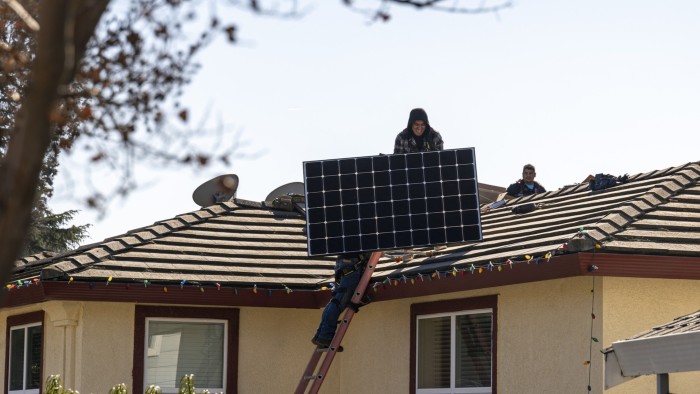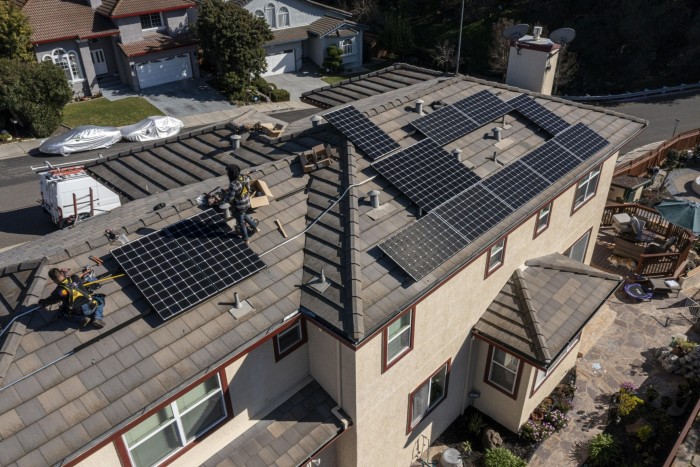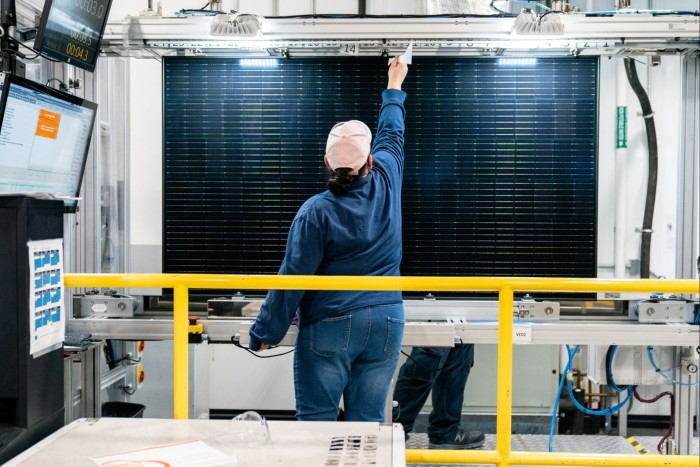Solar energy projects enlist legal help amid trade disputes

Roula Khalaf, Editor of the FT, selects her favourite stories in this weekly newsletter.
Governments and campaigners agree that solar power must be scaled up if the world is to combat global warming. But that does not mean the industry is immune to knotty legal disputes.
Although solar is now the fastest-growing energy source in the US, most of the cells needed to produce it are imported from abroad. As a result, the solar sector has been caught up in some of the biggest trade disagreements in recent years.
Back in 2012, when US president Barack Obama first imposed solar tariffs on China, Canada and south-east Asian countries stepped in to fill the void. But Canada’s solar industry was soon caught in the middle of a US-Canada trade war — solar panels were one of many products, including aluminium and paper, that the US added to its tariff list.
In 2018, this led to a political fight between the subsequent US president Donald Trump and Canadian prime minister Justin Trudeau. That year, the Trump administration had imposed tariffs on crystalline silicon photovoltaic (CSPV) cells, to spur domestic production. “Our action today helps to create jobs in America for Americans,” Trump claimed at the time.
More on FT.com: Best practice case studies
Read the FT Innovative Lawyers North America ‘Best practice case studies’, which showcase the standout innovations made for and by people working in the legal sector:
That year, more than 88 per cent of solar cells installed on homes or used by energy utilities in the US were coming from abroad, according to a Congressional Research Service report, and Trump’s government was concerned that solar costs would run out of control.
But the solar industry warned that Trump’s tariffs would in fact slow the growth of the market and cost tens of thousands of jobs. So three Canadian solar companies challenged the US in court, arguing that the levies violated free trade agreements.
To lead the legal challenge, those companies — Canadian Solar, Heliene and SilfabSolar — hired law firm Hogan Lovells. The fight dragged on for years. A hearing was held in 2021, and finally, in February 2022, the Canadians claimed victory; a dispute settlement panel ruled that the tariffs violated the US-Mexico-Canada Agreement (USMCA), which replaced the previous Nafta trade pact reached in 2018.
“The panel’s decision is an important victory for our solar industry clients who have made major contributions to the burgeoning North American solar sector,” Hogan Lovells partner Jonathan Stoel said in February.

A few months later, the Biden administration scrapped its tariffs on Canadian solar cells. “Reaching this settlement with Canada will promote greater deployment of solar energy in the US using products from one of our closest allies,” said US Ambassador Katherine Tai at the time.
But law firms’ involvement in the solar industry does not always involve disputes. Some are working with financial companies to fund installation costs for new solar panels on commercial and residential buildings.
This is a market that has come a long way since Elon Musk’s SolarCity, the country’s largest home solar installer, announced a $500mn leasing deal with Goldman Sachs in 2013. The company used the money to back leases for installing solar panels for its customers, who could then claim tax breaks. Meanwhile, the loans could be bundled into asset-backed securities and sold to investors.
Law firm Baker Botts has represented Sunnova Energy, a Houston-based solar energy provider, in similar solar-loan securitisation deals. In 2020, it helped Sunnova securitise $158mn of notes backed by a portfolio of solar loans in 17 US states and territories. In November, the company completed its eighth solar-loan securitisation, worth $155mn. Baker Botts also helped Sunnova securitise leases and power purchase agreements totalling $355mn.
Although rising interest rates and macroeconomic conditions have posed challenges for all securitisation this year, in the solar sector it is a “no brainer for investors” and for power supply companies, says Travis Wofford, a partner at Baker Botts.

By 2030, about 13 per cent of US homes are expected to have solar systems installed, according to Société Générale. The solar industry aims to reach 20 per cent of electricity generation in the US by 2030, up from 4 per cent currently, the bank estimates.
This is good business for the law firms, too. As solar panels and battery storage become cheaper and more efficient, Baker Botts has seen new entrants joining the market and asking for help. “Specifically, with the goal of eventually developing a securitisation programme themselves,” Wofford adds.
Until this year, only residential solar projects had been securitised. Then law firm Kramer Levin helped finance the first solar securitisation for business properties in a $403mn deal. It involved solar equipment construction on commercial and industrial properties.
Luminace, a North American division of private equity firm Brookfield Renewable, helped provide funding for the solar power purchase agreements. “Solar-related securitisations have gone straight up since 2013,” says Gilbert Liu, a partner at Kramer Levin. “Every year, there are more and more deals.”
Thanks to the US Inflation Reduction Act (IRA) — which passed in August, expanding the federal funding and tax breaks for renewable energy — the government has ensured support for solar projects that were previously “a little bit haphazard”, Liu says.
This is a much longer term commitment by the government to the renewable industry,” he says. “The IRA really purports to change the game in that there are multiple ways for you to monetise those tax credits.”
Comments